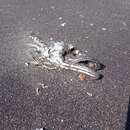Diagnostic Description
provided by FAO species catalogs
Head length 26.0 to 32.4% of standard length. Measurements in relation to head length upper jaw 43.7 to 50.2%, snout length 29.3 to 34.1% and eye diameter 14.9 to 18.9%; gill rakers long and slender with pointed tips, Total number on first arch 19 to 25 (mostly 19 to 23). First dorsal fin with I spine and 9 to 12 rays; second dorsal with 36 to 42 rays; anal fin with 36 to 42 rays; tips of pectoral fins always reaching to or extending beyond level of anal fin origin, caudal fin margin usually concave. Scales rather large, 106 to 130 along lateral line. Total number of vertebrae 48 to 53. Colour: silvery on back, silvery whitish on belly.
- Boerema, (1977)
- Ginsburg, (1954)
- Poulsen, (1957)
- bibliographic citation
- FAO species catalogue. Vol.10. Gadiform Fishes of the world (Order Gadiformes). An Annotated and Illustrated Catalogue of Cods, Hakes, Grenadiers and other Gadiform Fishes Known to Date.Daniel M.Cohen Tadashi Inada Tomio Iwamoto Nadia Scialabba 1990. FAO Fisheries Synopsis. No. 125, Vol.10. Rome, FAO. 1990. 442p.
- author
- Food and Agriculture Organization of the UN
Distribution
provided by FAO species catalogs
Two subspecies are recognized. The Peruvian population (M. gayi peruanus) is distributed off the coast of Peru from Paita (5°S) southward to Huarmey (around 14°), while the Chilean subspecies (M. gayi gayi) occurs off the coast of Chile from Arica (19°S) to the Chiloe Island (around 44°S).
- bibliographic citation
- FAO species catalogue. Vol.10. Gadiform Fishes of the world (Order Gadiformes). An Annotated and Illustrated Catalogue of Cods, Hakes, Grenadiers and other Gadiform Fishes Known to Date.Daniel M.Cohen Tadashi Inada Tomio Iwamoto Nadia Scialabba 1990. FAO Fisheries Synopsis. No. 125, Vol.10. Rome, FAO. 1990. 442p.
- author
- Food and Agriculture Organization of the UN
Size
provided by FAO species catalogs
Estimated maximum length: Peruvian subspecies 68 cm (males) and 115 cm (females), Chilean subspecies 87 cm; common to 50 cm for both subspecies.
- bibliographic citation
- FAO species catalogue. Vol.10. Gadiform Fishes of the world (Order Gadiformes). An Annotated and Illustrated Catalogue of Cods, Hakes, Grenadiers and other Gadiform Fishes Known to Date.Daniel M.Cohen Tadashi Inada Tomio Iwamoto Nadia Scialabba 1990. FAO Fisheries Synopsis. No. 125, Vol.10. Rome, FAO. 1990. 442p.
- author
- Food and Agriculture Organization of the UN
Brief Summary
provided by FAO species catalogs
Occurs from shallow continental shelf waters (around 50 m depth) to the upper continental slope down to around 500 m.Sometimes found off the bottom or in midwaters.Females grow faster than males and attain a much greater size. The main spawning period extends from August to March, with a peak in the southern spring (Peruvian subspecies), and from August to November (Chilean subspecies). The boundaries of the spawning ground of the Peruvian subspecies are estimated between 4°S and 8°S, while those of the Chilean subspecies are found in deep waters off Chile. The Chilean subspecies are found in deep waters off Chile.The Chilean subspecies feeds on fishes, crustaceans and squids.
- bibliographic citation
- FAO species catalogue. Vol.10. Gadiform Fishes of the world (Order Gadiformes). An Annotated and Illustrated Catalogue of Cods, Hakes, Grenadiers and other Gadiform Fishes Known to Date.Daniel M.Cohen Tadashi Inada Tomio Iwamoto Nadia Scialabba 1990. FAO Fisheries Synopsis. No. 125, Vol.10. Rome, FAO. 1990. 442p.
- author
- Food and Agriculture Organization of the UN
Benefits
provided by FAO species catalogs
The Peruvian population has recently become an important target fish for distant-water fisheries (from the sixties onwards). On the other hand, the Chilean subspecies has been an important food for the Chilean population since the forties. The combined catch for both populations reported to FAO in 1987 totalled 64 286 t, of which 32 026 t were taken by Peru and 30 905 t by Chile. The yield of the fishery has decreased very considerably. Caught with artisanal purse-seines and trawls. Most common fishing techniques are "demersal bottom trawling" and "purse seining". The total catch reported for this species to FAO for 1999 was 141 053 t. The countries with the largest catches were Chile (103 789 t) and Peru (37 121 t). Marketed fresh and frozen and also used for fishmeal.
- bibliographic citation
- FAO species catalogue. Vol.10. Gadiform Fishes of the world (Order Gadiformes). An Annotated and Illustrated Catalogue of Cods, Hakes, Grenadiers and other Gadiform Fishes Known to Date.Daniel M.Cohen Tadashi Inada Tomio Iwamoto Nadia Scialabba 1990. FAO Fisheries Synopsis. No. 125, Vol.10. Rome, FAO. 1990. 442p.
- author
- Food and Agriculture Organization of the UN

